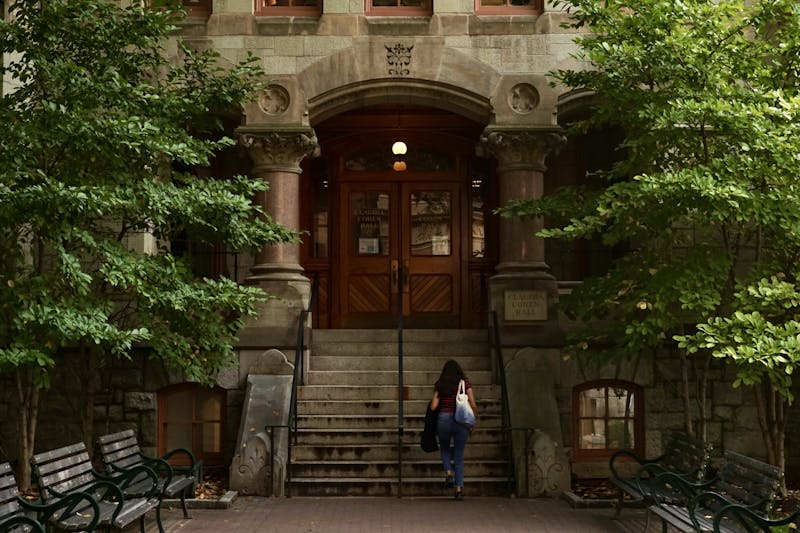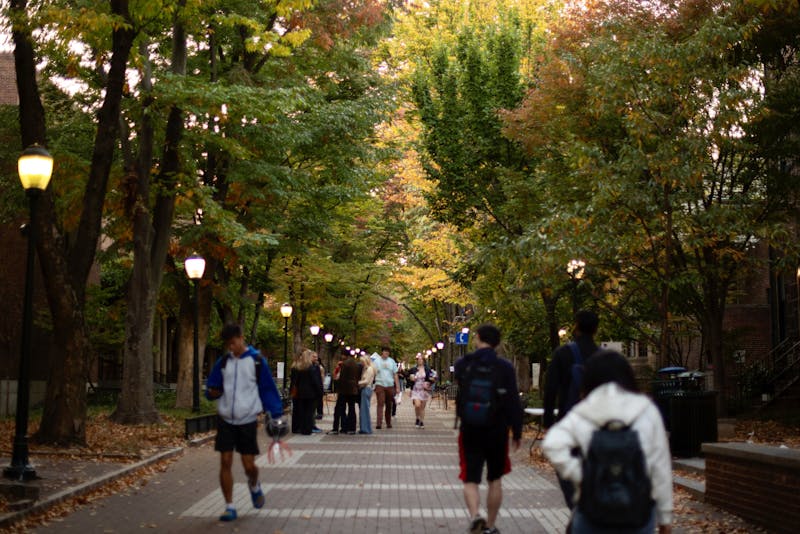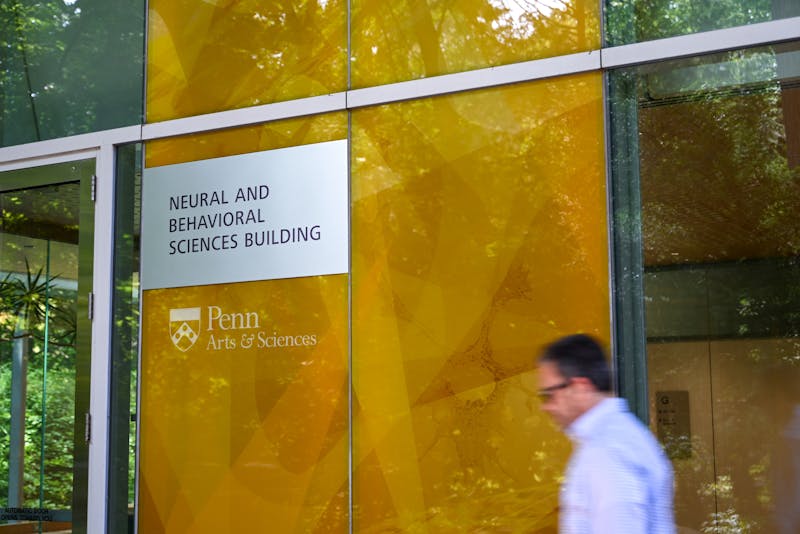
Wright's mural of St. Louis Cardinals legend Stan Musial was created with Rubik's Cubes and can currently be seen at Busch Stadium. | Courtesy of Connor Wright
Connor Wright is only a freshman, but he has already made massive murals for the St. Louis Cardinals and Facebook headquarters and counts Mark Zuckerberg as a fan.
Wright’s artistic career started with his senior thesis project at St. Louis Priory School.
Although his background was in math and science, he took a liking to pointillism after learning about it in his high school art history class. Pointillism is a painting technique in which small, distinct dots of color are arranged in patterns so that they blend to create an image in the viewer’s eye.
“When I came across pointillism, basically it’s like it has the exactitude of math but still has that freedom that art provides, so it’s like a combination of my two passions,” Wright said. “So I don’t have to worry about being a perfectionist because it’s gonna turn out exactly how I want it to turn out with no exceptions because it’s just the physical pieces and it gives you that liberation that I get through art.“
When he got home from class one day he noticed a Rubik’s Cube on his desk, and thought that if he had enough of them they could be used like pixels to create an image. That was when he got the idea for his high school senior thesis, to make a mural of St. Louis Cardinals legend Stan Musial, completely out of Rubik’s Cubes.
He got to work, first speaking to the senior vice president of Rubik’s Cube. At the time there weren’t enough available Cubes in the country to complete the project, so the company arranged for extra shipments from China. He then emailed the president of the Cardinals and convinced him to make space for the mural in Busch Stadium, the team’s home.
“He did say that if I were actually really passionate about the project then I would be able to come up with the money myself,” Wright said.
Wright ended up emailing parents of friends throughout the city offering to sell charcoal portraits to raise the roughly $20,000 needed to buy the cubes.
After receiving lessons from several pointillistic artists in Germany and New York via Skype, he successfully installed his project the day before the playoffs, a triptych of three Stan Musial portraits using 5,980 Rubik’s cubes.
The mural attracted a flurry of media attention from local news sources, with even The Washington Post publishing the headline, “Teen uses Rubik’s Cubes in least dorky way possible.”
“I am really impressed with Connor’s initiative, creativity and enthusiasm,” Cardinals President Bill DeWitt III told the Riverfront Times in 2015. “This remarkable mosaic of Rubik’s Cubes depicting Stan Musial is something our fans will be amazed to see when they visit Cardinals Nation.”
After the success of the mural, the St. Louis Children’s Museum reached out to Wright, then in the spring of his senior year, and asked him to make a similar one. Wanting to move away from Rubik’s Cubes, he decided to use crayons to design the St. Louis skyline.
Instead of laying out the 305,000 crayons by himself, he used an algorithm to convert the design into crayons. He then divided it up into 132 sections and sent each one to a different St. Louis grade school so that children could assemble the pre-planned boxes. Wright even taught art lessons on pointillism to some of the schools.
The mural current holds a world record for largest crayon mural in the world.
Wright felt that the mural brought a positive impact in a city reeling from the shooting of Michael Brown in the St. Louis suburb of Ferguson.
“Especially in light of events like Ferguson and stuff, the like St. Louis Post-Dispatch, and St. Louis publications really liked this because it was an opportunity for them to say this was our true colors, like this is what we really are,” Wright said.
His artwork goes along with his commitment to social impact. The summer before his senior year while he was working on his Rubik’s Cube project, he simultaneously raised $15,000 to supply books for four St. Louis schools without libraries as his Eagle Scout Service Project.
And when The Magic House offered Wright a $5,000 commission for his work, he declined it. Instead, he asked that the museum offer free admission for 5,000 children throughout the year who couldn’t otherwise afford the $10 admission fee, to which they agreed.
“I think the artwork is definitely large scale physically but I also think it can mean large scale in impact especially the bigger things tend to grab attention. So you’re able to say a lot with a little,” Wright said. “So when thousands of children across St. Louis came together to help make this mural it said a lot about our school districts. It said a lot about our teachers. It said a lot about the kids.”
After his second success, his third big break was when he met Priory alumnus and Chief Financial Officer of Facebook Dave Wehner. Wright, who was student council president at the time, got a chance to speak to Wehner when he came to speak at the school. He recalls Wehner telling him he shared Wright’s Rubik’s Cube mural on his own wall. They kept in touch, and Wehner eventually asked him to create something for the Facebook headquarters.
They brought Wright in as an artist in residence over the summer, during which he designed posters and learned screen printing techniques, all while contemplating ideas for a mural.
“They said only do a mural if you’re inspired,” Wright said.
Three days before his commission ended, Wright got the idea to use dominoes to make a portrait of Alan Turing, known as the father of computer science. For approximately 10 days, Wright lived at Facebook headquarters, working 10 hours a day on the mural. He took naps on the couch next to his work station, used the showers in the Facebook bathrooms and ate his meals in the cafeteria.
Wright recalls Mark Zuckerberg himself remarking that the piece was “looking awesome.”
“I turned around and there was Mark and I was like, I probably peed my pants he probably thought I was so weird. I don’t think I said anything else after that I kind of just stared at him and then he eventually walked away,” Wright said. “And then I had to walk around for 30 minutes and gather myself cause I was just so excited.”
He finished the mural in time to go home before starting his freshman year at Penn.
In October, Wright’s piece was one of 12 photos that Mark Zuckerberg posted to his Facebook account showing different pieces of artwork in the Facebook offices, and the only one posted to his Instagram. Zuckerberg called the piece “one of [his] favorites.”
“I was like ‘mom, I’m so excited,’” Wright said.
Despite Wright’s lengthy resume, his friends say he rarely talks about his success.
“He never talks about it unless provoked,” College freshman Julia Frontero said. “I can honestly say I haven’t met anyone like him.”
“He just randomly whipped out some art things,” College freshman Anna Barber said. “I didn’t know what a mural was, I didn’t know you did this big painting.”
“He’s really genuine,” Barber added.
“It’s definitely a passion of mine so when I’m talking to people about…what they love and I’m talking about what I love it’s kind of comes out,” Wright said.
Despite taking one fine arts class in photography, Wright does not plan to study art at Penn, instead considering a major in political science, or an uncoordinated dual degree with the Wharton School. He has toyed with the idea of starting his own company to make murals.
“The design’s fun, but it’s really really really tedious. Cause for a lot of it it’s just hand changing pixels to a different color and when you get to like 10,000 it can take quite a long time,” Wright said. “But just like the negotiations and the planning of everything and getting it together is probably one of my favorite parts because…the problem solving happens at every turn.”
Wright is also considering a career in politics, although he is not off to the best start. He was disqualified from the election for Class Board President by the Nominations and Elections Committee after it found that he violated the Fair Practices Code. He plans to run again in March, he said.
"I'm hoping to pull a Mak, for sure," Wright said, referring to 2018 Class Board President Makayla Reynolds, who was elected her sophomore year.
However, despite his interest in politics, Wright is wary of making his artwork overtly political or election-oriented.
"The problem with elections is that no matter what, half the people that see it are gonna be unhappy. And I wouldn’t want to make artwork that makes people not happy. I think that it’s definitely good to make socially relevant things, but it’s also really good to respect other peoples opinions and stuff like that no matter how unhappy you are with the election," Wright said. "How much impact can it actually have is kind of a question that you have to ask yourself."
And impact is what he values in his work, much more than making a statement.
"Social change I think is great when you exert your energy towards something that you can actually change…rather than trying to undo something that’s not undoable," Wright added. "I think statements are really cool, but I don’t think they’re lasting. Statements say a lot in a little amount of time. And I think impacts can sometimes do a little bit, but they last for a long amount of time. And I think that’s overall something that makes the biggest difference."
Despite his competing interests, Wright will not be giving up murals anytime soon. He is currently in talks with Instagram and Maybelline to create artwork. Additionally, he hopes to build a project for Penn during his time here.
“One idea that I was throwing around…would be making Ben Franklin out of buttons,” Wright said.
“That would trump all of them.”
The Daily Pennsylvanian is an independent, student-run newspaper. Please consider making a donation to support the coverage that shapes the University. Your generosity ensures a future of strong journalism at Penn.
Donate






